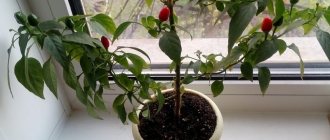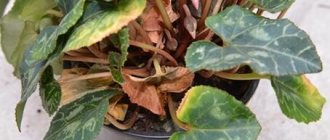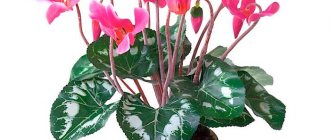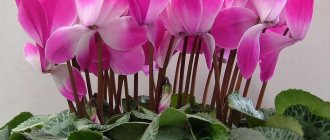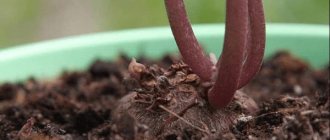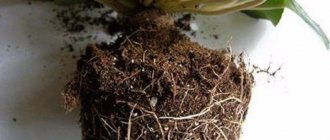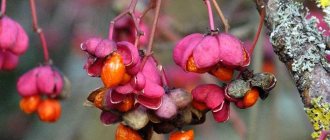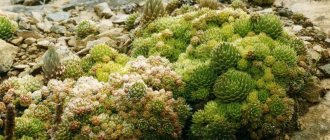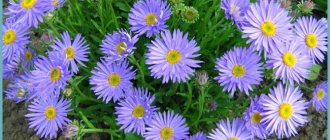If you believe the ancient legend, it was in the shape of a cyclamen flower that King Solomon decided to make his crown. The king liked the cyclamen with its discreet beauty and became a reminder to him that modesty is the quality of a truly wise ruler. The cyclamen flower really resembles a crown - delicate petals grow on a long graceful peduncle. It is not surprising that this charming, touching plant has won the sympathy of professional and amateur gardeners.
Very often, different types of cyclamen (and there are about twenty of them in total) are also called “Alpine violet”. This is not entirely correct, since Alpine violet is only European cyclamen or reddening (purple) cyclamen. In the wild, as the name suggests, it is found in the Alps. But in indoor culture this type of cyclamen is very rare. Only the most experienced flower growers will tell you where you can buy European cyclamen tubers and seeds.
European cyclamen is often confused with the so-called Persian cyclamen, a larger plant with a relatively early flowering period. Meanwhile, the “European” has characteristic features that are unique to him. Firstly, this is the only non-deciduous species of cyclamen. When the dormant period begins, it stops growing, but does not shed its leaves. Secondly, European cyclamen has smaller leaves and flowers. The leaves are round in shape, slightly elongated towards the tip. The edges of the leaves are smooth. Thirdly, the flowers of European cyclamen are usually bright pink. There are also very rare, so-called “alba forms” - simply white flowers or white with a crimson eye.
And finally, the flowers of the European cyclamen smell very pleasant; as the owners of the “Europeans” themselves write, the aroma varies from “simply pleasant” to “the aroma of expensive perfume” and even “divine”. The intensity of the aroma depends on the intensity of the color of the flower itself: the lighter the flower, the subtler the aroma. Interestingly, on the day they open, the flowers may not smell at all, and their petals are initially very thin and pale. Over time, the aroma intensifies, and the petals gain color, straighten and thicken.
It was already mentioned above that as an indoor flower, the “European” is now quite rare. So you are lucky if you have a truly real alpine violet living on your windowsill!
Botanical description and history
European or purple cyclamen, Latin name Cyclamen purpurascens, is one of the species of the Primrose family. A perennial herbaceous plant native to Southern Europe. In warm regions it grows wild and is cultivated in gardens. The plant is often called alpine violet or dryer . The tuber is spherical or elongated, up to 10 cm in diameter. Roots grow over the entire surface.
The leaves are petiolate, heart-shaped. There are small notches along the edges of the leaf plate. The upper part is green with a silver pattern, the lower part has a purple tint. The flowers are shaped like butterfly wings, their size is 2 cm. The buds are painted in various shades of pink and light purple. Flowering is long-lasting, up to 5 months. During this period, alpine violet spreads a pleasant aroma.
Attention : Purple cyclamen does not have a pronounced dormant period. It does not shed its leaves, maintaining its decorative appeal all year round.
Alpine violet (European cyclamen)
And the name of cyclamen often contains the word “violet”. But alpine. Famous poets did not ignore this flower.
What type does it belong to?
Calling it a violet is not entirely correct . Or rather, even incorrectly:
- Perennial plant . Due to their massive growth in the Alpine mountains they received this name. Some other species grow along mountainous coasts: the Mediterranean Sea (even in the northeastern regions of Africa;
- Black Sea;
- Caspian Sea.
- Where the climate is warm and humid.
There are 22 known species of these plants . They are from the Primrose family. And they correctly call it Cyclamen.
Interesting! They have been grown as houseplants since 1656.
What is it called differently?
Cyclamen (lat. Cyclamen) . This is how it is correctly called among specialists and flower growers. These are not all of its names.
European cyclamen is one of the types of such flowers . The most famous. And quite often found in the collections of flower growers. It can bloom even without special dormant periods. Easier to grow in apartments.
There are other types. Which grow in natural conditions:
- African;
- Cypriot;
- Persian;
- Colchis;
- Grecum;
- Kossky.
But even experienced gardeners have problems growing some in apartments.
Important! Many of them are on the verge of extinction due to climate change. And man made his contribution to this process.
Detailed description of appearance
Corm plant . The tallest representatives reach no higher than 30-35 cm . Low-growing ones grow only up to 15 cm:
- Leaves: Green, heart-shaped and with a characteristic light pattern. They are also called marble spots in certain varieties;
- On petioles slightly more than 10-12 cm long, there are about a dozen of them in the bush;
- And the largest ones are no more than 15 cm in diameter.
- Their coloring suits every taste: from white to violet (scarlet, pink, lilac, purple).
What do the tubers look like?
The tubers of the flower and the addiction of wild boars to them gave another name - Pork bread :
- They are round with a small hole in the middle . Slightly similar to flattened beets. Or radish;
- Some species do not even have rounded outlines. With age;
- The roots are fibrous . They are not the same for everyone: From the bottom of the middle part of the tubers of Persian cyclamen;
- Cyclamen europaea has tubers on all sides.
Important! You have to be careful with the plant. Exposure to toxic substances even causes trembling in animals. Or crap. That's why they called it Dryakva. It even causes skin irritation. If you are caring without gloves. And keep away from small children.
Photo
Is Grandma's cyclamen a separate variety?
Discussions about “grandmother’s” cyclamen are being held among experienced gardeners. And those who consider themselves experienced. Its popularity and increased interest are not only in the name.
Grandmother's cyclamen is especially popular among beginners - caring for it is not at all difficult. He has virtually no rest period. And this is what interests flower growers most of all. Because they bloom longer.
Lovers of this flower with experience and age have become accustomed to the name “grandmother’s”. actually the species cyclamen Cyclamen purpurescens . It has been called that way for more than 15 years. Renamed from European.
In addition, it is capable of reproducing by root shoots . Flower growers call them fingers.
How to distinguish from the Persian species?
For an experienced gardener, it will not be difficult to distinguish between two types of popular indoor plants. By what characteristics are flowers distinguished?
- The structure of the tuber is that the Persian species has a flat-round tuber with a diameter of up to 15 cm, with roots growing in the lower part. European cyclamen has roots throughout the tuber.
- Flowering time - Persian blooms from autumn to late winter, European - in spring and summer.
- The size and color of flowers and leaves - European cyclamens are smaller than Persian ones, the length of the flowers is 2 cm, the diameter of the leaves is 3-4 cm. The plants are distinguished by a strong, pleasant aroma of flowers. The back side of the leaves of the Alpine violet is purple, while that of the Persian cyclamen is green.
We wrote about the delicate beauty and rules for caring for Persian cyclamen here.
Watch a video about the differences between European and Persian cyclamen:
Propagation of Persian cyclamen
In the species Cyclamen persicum, unlike Cyclamen europaeum, tubers are not formed during growth and development, and therefore it is quite problematic to apply the vegetative method of propagation in practice. Despite the fact that the theoretical description seems quite simple - the tuber is cut in half, the sections are dried, sprinkled with charcoal dust, after which the halves of the tubers are planted in separate pots, experienced flower growers do not recommend propagating the flower in this way. The reason is that most often after such division, rot forms on the cut halves and the tubers die.
Growing from seeds is used by indoor flower lovers much more often, and a positive result is achieved without much difficulty. It is necessary to note another positive aspect of seed propagation - grown young plants have better adaptability to home conditions compared to purchased ones. Seeds for planting can be used purchased or obtained from your own flowering cyclamen. The only peculiarity is the need for artificial pollination of ripe pollen, which is recommended to be repeated for several days in a row. As the seeds ripen, the peduncle bends closer to the soil and curls slightly. It is advisable to separate the seed pod yourself before cracking and give it time to ripen.
Persian cyclamen seeds
It is advisable not to store the collected seeds for a long time, but to sow them immediately after the capsule cracks or over several months.
In a prepared planting container filled with substrate, it is necessary to draw several grooves 1-2 cm deep and water well. Then the seeds are placed in the grooves at a distance of 3-5 cm from each other and covered with earth.
The optimal temperature for seed germination is 18-20ºС; the container must be moved to a dark room. As a rule, shoots appear in 1-1.5 months.
You can start picking after two leaves appear, and the small tuber is completely covered with earth. After six months, it is advisable to plant the young plants in separate pots, burying the tuber 2/3 into the ground. Young alpine violets bloom only the next year after planting.
Photo
The photo shows European and Persian cyclamen, you can see the differences between them.
European
Persian
Medicinal properties
Juice and infusion of alpine violet roots helps with various diseases of the female genital organs, rheumatism, and neuralgia. Particularly effective are cyclamen-based preparations intended for the treatment of respiratory organs. The juice of the plant contains alkaloids, saponins, essential oils, and astringents . They have anti-inflammatory and antiseptic effects.
When treating colds, sinusitis and sinusitis, medications containing cyclamen juice “Sinuforte”, “Neonox” are prescribed.
Important : The content of toxic substances in the roots of the plant can negatively affect your well-being. Infusions are used with caution, after consultation with a doctor.
Rules for landing (transfer)
Choose a small pot for planting . The container should be 2-3 cm larger than the diameter of the tuber. The material has no special requirements; it can be ceramic or plastic. When planting, it is important to remember that the tuber is completely buried. Transplantation is performed rarely - once every 3-4 years. The best time is early March. At the same time, daughter nodules are separated for reproduction.
Watch a video about the rules for transplanting (planting) cyclamen:
Choosing a location and lighting
European cyclamen requires careful selection of placement. The flower needs good, but diffuse lighting. East and west windows are recommended. On the south side, high-quality shading will be required to avoid burns on the leaves.
Fresh air is vital for the alpine violet . She is sensitive to foreign odors; the pot should not be placed in the kitchen or smoked near it. At the end of spring, the flower is placed on the balcony or in the garden, always in partial shade.
Soil requirements
The substrate should be loose and light. On heavy soils, purple cyclamen lags behind in development. The best option is to buy a special balanced mixture in the store. You can prepare the substrate for planting yourself; you will need:
- leaf soil;
- peat;
- humus;
- coarse sand.
Tip : Recommended soil acidity is 5.5-6.5 pH (slightly acidic or neutral).
European
The plant (blushing) is widespread in Central European countries (northern Italy, Slovenia, Macedonia). This is a herbaceous evergreen plant with a flat-round tuber (it is slightly flattened with a single growing point). With age, the tuber of the flower becomes deformed and produces thick shoots that have their own growth points.
The leaves of this type of dryer are basal with a silver-green color. They are heart-shaped with a pointed tip and a slightly jagged edge.
The underside of the leaves is purple-green. The flowers are five-petaled, solitary, with very long peduncles. The petals are oval shaped and slightly twisted into a spiral. A special feature of the European dryer is its sharp and delicate aroma.
Did you know?
One of the varieties of European dryer - purpurascens, is distinguished by very beautiful crimson or violet-pink flowers.
Translated from Latin, the word “purpurascens” means “to turn purple.” Flowering continues throughout the growing season - from spring to autumn
. The color of the flowers varies: light purple, pale pink, bright purple, pink-violet.
Breeders have developed several forms of European cyclamen, which differ in the flowering period and color of the flowers.
The following varieties are popular with many: purpurascens (purple-pink flowers), carmineolineatum (white flowers), lake garda (pink flowers), album (white flowers).
Cyclamen is divided into different types and subspecies (varieties), but one of the most common and popular types is African
.
The bush thickets of Tunisia and Algeria are considered the birthplace of the African dryer. According to the botanical description, this type of plant is similar to the ivy-leaved cyclamen. There are two forms of African cyclamen: diploid and tetraploid.
The diploid form of African dryweed has smaller leaves with different petiole shapes and more fragrant flowers. For decorative purposes, it is customary to use the diploid form of African cyclamen.
The leaves of this plant are heart-shaped. Color silver-green. The leaves of the African dryer grow directly from the tuber, reaching a length of 15 cm
.
This is one of the main differences between this type of plant and ivy-leaved cyclamen. The plant blooms from spring to autumn, and young leaves begin to appear only in September-November.
The color of African cyclamen flowers varies from pale pink to deep pink.
Important!
Dryakov contains substances that are toxic to dogs and cats.
This type of plant is afraid of frosty winters, so it requires special shelter. The flower also does not tolerate hot sun (it is not for nothing that in North Africa it is found only in bush thickets, where there is a lot of shade).
The African drab is characterized by very rapid growth and development compared to other representatives of the Myrsinaceae subfamily. During the period when the plant sheds its leaves, it requires a cool (about 15ºС) and dry place.
Alpine cyclamen
has a very vague history. At the end of the 19th century, Cyclamen alpinum was discovered and included in the list of plants of the Myrsinaceae subfamily.
But over time, some plants disappeared in cultivation; until 1956, the alpine tree weed was considered an extinct species. The epithet "alpinum" has long been used to refer to cyclamen intaminatium.
There was some confusion in terms, botanists decided to introduce a new name for the Alpine tree weed - cyclamen trochoteraptum. This term is still used by many scientists today, although in the early 60s Davis confirmed that Cyclamen alpinum had not disappeared.
At the beginning of 2000, 3 expeditions were sent to study this type of dryer. The expedition participants confirmed that alpine cyclamen grows in the wild to this day.
Did you know?
In the Middle Ages, it was believed that for a successful birth, a pregnant woman had to wear a cyclamen flower as decoration.
The main difference between this type of plant is the angle of the flower petals (90º instead of the usual 180º
). The petals are slightly curled and look like a propeller.
The petals range in color from carmine pink to pale pink with a purple-violet spot at the base of each petal.
The aroma of the flowers is very pleasant and delicate, reminiscent of the smell of fresh honey. The leaves of the alpine tree are oval in shape with a characteristic gray-greenish color.
Home care: recommendations and advice
The life cycle of a houseplant is divided into two phases: vegetation and dormancy . The growing season lasts from spring to late autumn. At this time, the recommended air temperature is 15-18°. In winter, the flower is transferred to a cool room, where it is 12-15°. At rest, the growing points fall asleep, but the leaves remain green.
Withered peduncles and leaves should not be torn from the tuber. They are removed by twisting them around the axis.
Watering . During the growing season, watering is regular and even. Do not allow drying out or stagnation of water. The best option is bottom watering through a tray. The water is soft, settled, and at room temperature. The need for moisture is checked by the top layer of soil - if it is dry, it’s time to water the flower. In winter, moisture is reduced to a minimum.
- Feeding . During the period of active growth and flowering, the plant is fed once every two weeks. Complex mineral fertilizers are used. Preparations for flowering plants are suitable, but the recommended dosage is halved. In winter, fertilizing is not carried out. Fertilizing should be low in nitrogen; this element contributes to tuber rotting.
- Transplant . Purple cyclamen react negatively to transplantation. The procedure is performed rarely - once every 3-4 years. It is produced by the transshipment method, with minimal trauma to the roots. A layer of drainage is poured into a larger pot, and the free space around the tuber is filled with fresh soil.
Watch a video about the rules of caring for cyclamen:
Replanting cyclamen
In most cases, cyclamens are replanted in the second half of summer, when small leaves have already begun to appear.
The pot should be selected in such a way that the distance between the tuber and the edge of the container does not exceed 3 cm. Drainage must be used so that the young plant does not rot. Due to the fact that cyclamen are very susceptible to various infections, the soil should be well warmed and disinfected with a solution of potassium permanganate.
Also, do not bury the transplanted flower too deeply. At least 1/3 to half of the tuber should remain above the ground surface.
At the initial stage, cyclamen in a pot should be watered moderately, and during the process of active leaf growth, fertilize and switch to abundant watering.
More details How to water cyclamen in a pot
Common diseases and pests
The causative agents of cyclamen diseases are fungi and bacteria. Detection of the disease and timely treatment will help save the plant.
- Wet rot is a bacterial disease that manifests itself in the rotting of a tuber. Symptoms: lethargy, drooping leaves and flower stalks, putrid odor from the soil. There is no treatment; the flower is destroyed to prevent the spread of infection.
- Fusarium is a fungal disease that affects the blood vessels of a flower. Infection occurs through the root system. Symptoms: leaves turn yellow from the tops. Treatment: watering with a solution of foundationazole, spraying with Topsin-M.
- Gray rot - fungal spores are carried by wind or water. Plants kept at high humidity and low temperature are affected. Symptoms: a coating of gray mold on the leaves, peduncles and stems darken, then die. Treatment: remove the affected parts, treat the plant with a systemic fungicide.
The most common enemies of cyclamen are mites, thrips, aphids, and scale insects.
The cyclamen mite is a small pest (0.1-0.3 mm) that cannot be detected upon inspection. Mite colonies develop on the undersides of leaves. When large accumulations occur, they resemble a layer of dust. The activity of pests leads to deformation of leaves and flowers, twisting of the stem, and slower growth. Infected leaves are torn off, the plant is sprayed with Agravertine solution mixed with liquid soap.
- Aphids are a common plant parasite that feeds on plant sap. Pests stay on the back side of the leaves, but when they multiply significantly they become noticeable. The systemic insecticide "Aktara" will help destroy them. Before processing, it is recommended to rinse the leaves under running water.
- Scale insect - the insect looks like dark spots on the stem and leaves. It is inactive and feeds while sitting in one place. Adult scale insects are removed with a swab soaked in alcohol. Sprawling larvae are removed with insecticides “Karbofos” and “Aktellik”.
- Thrips - elongated bodies of pests are painted white or black. Insects feed on flowers and leaves, causing brown spots and deformation. Thrips are mobile; adult individuals fly to neighboring plants. Three-time treatment with Condifor, Kinmiks or Ditox will help get rid of the pest.
Attention : Sick plants are immediately isolated from healthy ones. Keeping in quarantine will prevent the spread of infection.
Growing from seeds
Cyclamen seeds
Cyclamen grown from seeds is more hardy than a ready-made specimen from the store. From birth he is adapted to the conditions of the home environment.
You can sow cyclamen all year round, but the best period is February-March. At this time, daylight hours increase and seedlings do not need additional lighting.
Containers and loose soil for crops are prepared in advance. Cyclamen seeds are large, with a dense skin. They are first soaked for a day in water or a solution of growth stimulants. Then they are embedded in a damp substrate to a depth of 0.5 cm. The containers are covered with film to keep the soil moist. The crops are ventilated daily and checked for seedlings. They germinate unevenly, with the first seedlings appearing within 2-4 weeks. Favorable conditions are created for young plants: they select a well-lit place, control soil moisture, preventing drying out, and make sure that young nodules are completely covered with soil. The cover from the crops is removed when they get stronger and fully expand their leaves. During this period, within 1-2 months, the root system of cyclamen intensively develops. Through the walls of the transparent containers you can see how the roots are gradually filling the soil, which means it’s time to plant the plants.
It is convenient to plant seedlings in 200 ml plastic cups. A drainage hole is made at the bottom, then they are filled with nutritious, moist soil. Before picking, the plants are watered, one at a time removed from the common nursery and transplanted into cups. The first time after picking, the seedlings are watered when the soil dries out a little. For normal growth, cyclamens are provided with the necessary conditions: diffused sunlight, coolness, watering and fertilizing. The growing season of indoor cyclamens lasts 10-12 months. Therefore, if sowing was carried out, for example, in February, then a year later you can get a flowering plant.
Features of reproduction
Alpine violet reproduces by separating daughter tubers and seeds . The first option is easy to implement and makes it possible to quickly obtain a young flowering plant. It is enough to cut off the formed tuber and plant it in a separate pot.
It is necessary to use loose neutral soil. A universal mixture for flowering plants, to which coarse sand is added, is suitable. The daughter tuber is completely buried in the ground.
Propagation by seeds takes a long time . At home, artificial pollination of flowers will be required. Before planting, it is recommended to soak the seed material for 20-24 hours in a zircon solution. The seeds are sown in a mixture of peat and vermiculite (1:1), sprinkled with sand on top.
Before emergence, cover with dark film. Germination takes about 1 month; the soil is periodically moistened. The resulting seedlings will bloom in 8-14 months.
Watch a video about the propagation of European cyclamen by tubers and seeds:
Pot for cyclamens
Before the transplantation and planting procedure, you should select and prepare a flower pot for cyclamen. The dimensions of the latter depend on the age of the plant.
Cyclamen is watered from below, so when choosing a pot for cyclamen, pay attention to this model
If the flower is 1 or 1.5 years old, the diameter of the vessel will not be more than 8 cm. If the pot diameter is 15 cm, a 3-year-old flower is perfect. Also, do not forget that the distance between the tuber and the edge of the flowerpot itself should not exceed 3 cm.
To prevent excess moisture and the onset of rotting of cyclamen, expanded clay or ordinary pebbles should be placed in the pot.
There are several methods for propagating such plants at home, but propagation using seeds gives a high probability that the number of these very beautiful and easy-to-care indoor plants will increase.
Similar plants
The genus Cyclamen includes 20 species, among them:
African cyclamen - a characteristic feature of the plant is the appearance of peduncles before the leaves. The flowering period is from spring to autumn, then leaf fall and a dormant period. The color of the buds is pink, the leaves are up to 15 cm in diameter.
- Colchian cyclamen is a rare species listed in the Red Book. The flowers are small, the leaves are green without a pattern.
- Cyclamen ivy or Neapolitan is its homeland on the Mediterranean coast of France and Turkey. The leaves are serrated with a characteristic silvery pattern.
- Cyclamen Kos - found on the island of Kos, Crimea and the Caucasus. Blooms in spring, petals are white, pink and reddish. The leaves have a silver marble pattern.
- Cyprus cyclamen is an endemic species that grows on rocky soil. The flowers are fragrant, white or pink with a purple base. Flowering time is from September to January-February.
You will find additional information about all types of cyclamen in this article, and about popular varieties from the Cyclamen Mix seed mixture, as well as how and where they can be planted, read here.
Features of cultivation
The cyclamen root is a flattened round corm up to 15 cm in diameter with a single growing point. Damage it and destroy the bulb. Cyclamen leaves are basal, leathery, heart-shaped, growing on petioles up to 30 cm long, dark green in color with a grayish-silver pattern. The original shape of the flowers is similar to outlandish butterflies - the petals are bent and pointed, sometimes have a fringed shape, and the color palette is incredibly wide - boiling white, pink, all shades of red, burgundy and purple. Cyclamen blooms for longer than three months.
There is an opinion that indoor cyclamen is a capricious plant. Don't believe it! Cyclamen is unpretentious, it’s just that its agricultural technology, like the agricultural technology of any other plant, has certain requirements, the obligatory fulfillment of which will allow you to easily cope with its cultivation. So:
- Pelargonium (Pelargonium) – care, photos, types
- Do not under any circumstances store faded cyclamen tubers in the refrigerator - after such storage the bulb will not wake up;
- the cyclamen flower does not tolerate heat and stuffiness, but lives well in a cool room at a temperature that is uncomfortable for humans - only 6-12 ºC;
- direct sunlight can cause burns on the beautiful cyclamen leaves;
- do not bury the cyclamen tuber in the ground: at least a third of the bulb should remain on the surface;
- cyclamen does not tolerate excess mineral salts in the soil, so be careful with fertilizers;
- The pot for cyclamen needs to be small, so that from the bulb to the wall of the pot there is a layer of soil no thicker than 2-3 cm.
They also often look for cyclamen instead of cyclamen. It's nothing. We will tell you how to grow both flowers.
In the photo: White cyclamens in a pot

